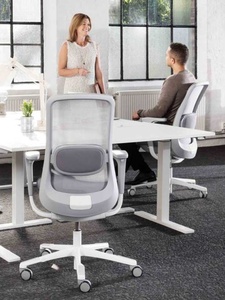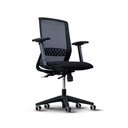In every organisation, ergonomics often sits quietly in the background: acknowledged, documented, yet rarely examined in detail. Beneath that quiet surface lies one of the most underestimated drivers of workplace injury claims, equipment non-compliance.
When workstations fall short of ergonomic standards, whether through outdated policies, neglected assessments or poorly fitted equipment, the result is not simply discomfort. It creates a direct pathway to musculoskeletal (MSK) disorders, absenteeism and costly claims. These injuries rarely appear overnight; they develop gradually, shaped by everyday tools that are not designed or adjusted to support the people using them.
Our previous blogs, Compliance at Risk and Outdated DSE Policies, explored how fragmented compliance frameworks and legacy DSE policies create silent vulnerabilities in workplace health and safety. This month, we draw those themes together, focusing on the ergonomic blind spots that allow poor equipment compliance to persist, and examining how these unseen gaps are now a leading cause of MSK injury claims.
Why Equipment Compliance Cannot Be Treated as a Box-Ticking Exercise
For many organisations, ergonomics is reduced to posture advice or reminders to take regular breaks. The cornerstone of a safe ergonomic programme, however, is equipment compliance — ensuring every chair, monitor, keyboard and desk is designed, adjustable and used correctly.
Systematic reviews show that well-executed ergonomic interventions, particularly those focused on workstation design, can reduce musculoskeletal symptoms substantially. See the recent meta-analysis of ergonomic interventions for detailed findings.
The Health and Safety Authority (HSA) highlights that poor posture, repetitive movement and inadequate equipment design are major contributors to work-related injury in Ireland. Many employers assume that purchasing “ergonomic” furniture automatically satisfies legal obligations, but true compliance requires correct adjustment, ongoing assessment and proof that standards are continuously met.
Blindspots That Drive MSK Injury Claims
MSK claims often originate not from catastrophic incidents, but from accumulated strain over weeks, months or years. These are the blindspots where small oversights compound into injury.
1. Generic or Inappropriate Equipment
Organisations often adopt a “one size fits most” approach. Desks, chairs and accessories are purchased in bulk, with little consideration for the user’s height, reach, or the nature of their work. When equipment is not adjustable or properly configured, posture suffers and injury risk rises.
2. Legacy Policies That Fail Modern Work Patterns
As outlined in our earlier blog Outdated DSE Policies, many policies are relics of pre-hybrid office culture. They fail to reflect new realities such as hot-desking, flexible hours or remote work. These outdated documents create compliance gaps that regulators are increasingly identifying.
3. Unimplemented Assessment Recommendations
Assessments often highlight required adjustments or equipment replacements. However, due to budget constraints or lack of follow-up, these recommendations are sometimes ignored. The result is an illusion of compliance, paperwork without protection.
4. Assessments Conducted Once, Then Forgotten
Workstation assessments are not static. Employees change roles, furniture is moved, and new technology is introduced. When assessments are not revisited, previous conclusions become obsolete, and the risk profile evolves unnoticed.
5. Neglecting Remote and Hybrid Setups
DSE obligations extend to all locations where work is undertaken, including home offices and remote environments. Despite this, many employers overlook remote workstations, leaving employees to improvise with kitchen tables and unsuitable chairs.
6. Procurement Without Ergonomic Oversight
Purchasing decisions often prioritise cost or aesthetics over function. Without ergonomic input at the procurement stage, even new offices can start out non-compliant.
7. Failure to Recognise Psychosocial Interactions
Ergonomics is not purely physical. Workload, time pressure and stress amplify postural tension and exacerbate MSK risk. The most effective ergonomic strategies recognise these psychological influences as part of a holistic risk model.
From Blindspot to Compliance: A Framework for Action
Transforming these blindspots into strengths requires a structured, organisation-wide approach.
1. Embed Ergonomics into Governance
Integrate ergonomics into your safety management system. Assign responsibility for DSE policy, assessments and procurement oversight. Ensure leadership recognises ergonomics as a strategic safety and productivity issue, not an administrative task.
2. Strengthen Risk Assessment Processes
Carry out comprehensive workstation assessments for all habitual DSE users — anyone working for one hour or more at a screen. Use validated ergonomic risk tools recommended by the HSA and ensure assessments are repeated when workstations, roles or health needs change.
3. Enforce Equipment Compliance
Every workstation must meet the requirements set out in Part
2, Chapter 5 of the Safety, Health and Welfare at Work (General Application)
Regulations 2007, including Regulation 72 and Schedule 4.
Key elements include:
- Adjustable seating with lumbar support
- Monitor height and tilt adjustability
- Adequate space for leg movement
- Separate, movable keyboard and mouse
- Glare control and sufficient lighting
Equipment that fails to meet these standards should be replaced or adapted immediately.
4. Integrate Ergonomics into Procurement
Create an approved equipment list that specifies compliant, tested models. Require ergonomic verification before purchase and document compliance checks as part of procurement records. This aligns financial control with legal responsibility.
5. Prioritise Training and Employee Awareness
Compliance depends on correct use. Provide regular training on how to adjust and maintain workstations, both in the office and remotely. Supplement this with short guides, internal communications and reminders to encourage regular self-checks.
6. Monitor and Measure
Track performance indicators such as assessment completion rates, unresolved recommendations, reported discomfort, absenteeism and MSK claims. Regular data review turns ergonomic management into a measurable, proactive process rather than reactive problem-solving.
7. Audit and Continuous Improvement
Conduct periodic internal or external ergonomic audits to verify compliance and uncover drift. Compare findings against the latest HSA and IBEC guidance. Update equipment standards and training accordingly.
8. Link Ergonomics to Incident and Claims Management
Include ergonomic factors in incident investigations and claims reviews. If an MSK claim arises, check whether workstation compliance was verified and recommendations implemented. This not only reduces future risk but demonstrates due diligence to insurers and regulators.
The Data Behind the Risk
Figures from the HSA confirm that musculoskeletal disorders remain one of the leading causes of workplace injury in Ireland. Approximately 40 per cent of reported injuries in health and social care are MSK-related, often caused by repetitive or awkward movements and poorly designed workstations.
Construction and office-based roles show similar trends, with cumulative exposure to poorly adjusted equipment resulting in chronic back, neck and upper limb disorders.
Research from the Irish Institute of Occupational Health and Safety also reveals that underreporting remains a major challenge, particularly in remote or freelance work. Many employees normalise discomfort until it develops into a claimable injury.
These findings underline the importance of proactive ergonomic management, regular review and strict adherence to DSE compliance standards.
Conclusion: From Awareness to Action
Ergonomic blindspots are rarely the result of deliberate neglect. They form quietly, in the space between outdated policy and day-to-day practice, or between procurement and real-world use. Yet their consequences are tangible , including rising injury claims, lower productivity, and reputational and legal exposure.
By embedding ergonomics into governance, maintaining compliant equipment, and ensuring regular reassessment and training, organisations can eliminate these blindspots before they become liabilities.
The return on investment is clear: fewer claims, healthier staff and a culture that values wellbeing through design, not just documentation.
Why not take our FREE health and safety compliance assessment and see if there are any gaps in your policy : Start Here















